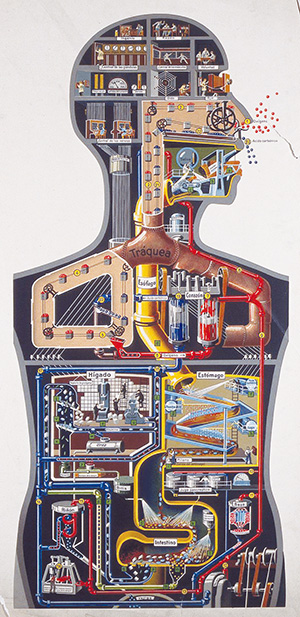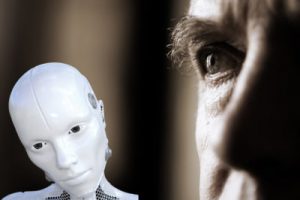Machine Intelligence & Human Intelligence: What is the Difference?

special sepia photo toned f/x, focus point on eye
We hear a lot about Artificial Intelligence today. It is a phrase that refers to a kind of intelligence that machines can function with, and over the last few decades this functionality has developed extremely rapidly. But how did this machine intelligence originate, and what exactly does it means to call a machine “intelligent”? Intelligence is a word that since time immemorial has been applied to human beings and other living creatures, but only very recently to machines, so how does this new machine intelligence relate to, and differ from, our human intelligence?
Nature as a Machine
To answer these questions, we must first understand what originally motivated people to instil intelligence into machines. If we go back to the Middle Ages, the first astronomical clocks that began to appear in public places during the early decades of the fourteenth century exercised a fascination over people. Nobody regarded these clocks as intelligent, but they were clearly a manifestation of intelligence, for they were able accurately to represent the motions of the sun and moon (and in the more complex clocks the motions of the planets as well) against the background of the zodiacal constellations. It was an extraordinary technological achievement, and it led people to think that if the motion of the sun and stars could be replicated by a mechanism, then this implied that the whole cosmos could be thought of as a great machine. This idea began to impress itself onto the human psyche during the fourteenth century when, for example, the philosopher, theologian and astronomer, Nicole Oresme, put forward the image of God as a divine clockmaker. According to Oresme, God designed and made the universe as a vast mechanism, set it going, and then left it to run by itself.1

In subsequent centuries, as the clock became smaller and more widespread, at first entering the houses of the wealthy, hanging rather inelegantly upon their drawing room walls, and later in more compact designs sitting upon the mantelpieces of middle class homes, it was a daily reminder to more and more people that the universe could be imagined as a great machine, and every creature in it as a more or less complex mechanism. By the time of the Scientific Revolution in the seventeenth century, the mechanistic worldview was one that many educated people could accept. Descartes’ characterisation of the human body, like that of every other living creature, as a machine was an idea whose time had come.2
Learning to Think Like a Machine
Behind this idea was a further idea that became the driving force of the Scientific Revolution. If the universe and all creatures in it are machines, then for human knowledge to be reliable, our thinking must align itself with the way the world is put together. In other words, we have to learn to think in the same way that machines function. This requires that we analyse nature’s mechanisms first by taking them apart, just as if we were taking a clock apart, reducing them to their smallest and simplest components. In this way, it should become more evident how each part relates to every other part, and we are then in a position to understand how they fit together to make a whole. Descartes’ Rules for the Direction of the Mind (1629)in effect describes exactly how to think like a machine.3 At roughly the same time, Francis Bacon wrote in the preface to his manifesto of the Scientific Revolution, the Novum Organum (1620),“the entire work of understanding” must be commenced afresh and the mind be “guided at every step and the business be done as if by machinery.”4 Thus the image of the machine came to be applied to the inner life of the human being. The operation of the machine became an ideal to which human beings intent on the acquisition of knowledge must conform their own thinking.
Both Bacon and Descartes were convinced that ordinary human language gets in the way of doing this really effectively, because it is full of vagueness and imprecision. If we are seeking to understand a universe composed of parts external to other parts, they believed it is necessary to devise a science that can match the mechanical precision of nature in its mode of expression. Descartes saw that what was required was to adopt the precision of mathematical thought as the ideal of scientific enquiry. This meant that the qualitative aspect of nature should be re-expressed in terms that could be quantified, for only then would our knowledge achieve sufficient exactitude. Only then would it become useful knowledge, because it would give us the ability to manipulate, control and utilise that which we have come to know. As Descartes explained, the mathematical method would enable us to “render ourselves as the masters and possessors of nature.”5
There was always something of a Faustian bargain at the heart of the mechanistic worldview and methodology that underpinned the Scientific Revolution. In order to gain mastery over nature, nature had to be quantified, which meant that those who dedicated their lives to science had to render themselves into calculators, committed to a certain kind of thinking from which anything smacking of felt experience or spiritual intuition was excluded. In other words, seekers of knowledge had to submit their inner life to a certain curtailment. Since only the kind of thinking which was, or could be, conformed to mathematics – namely, calculative thinking – would count as legitimate, what could not be quantified fell outside the purview of legitimate knowledge. Thus, for Galileo, all qualitative phenomena should be regarded as illusory, and only those aspects of phenomena that could be quantified should be regarded as real.6 What began as a methodological principle became a way of redefining the reality being investigated.
In 1642, as if to make entirely explicit the mechanical nature of calculative thinking, Pascal invented his mechanical calculator. It was a relatively simple yet ingenious device, the mechanism of which was reminiscent of a clock. It was capable of adding and subtracting and, through repeated additions and subtractions, of multiplying and dividing. What was so ground-breaking about the mechanical calculator was that it substituted the rotation of cogs and wheels for the human mental effort required to perform mathematical calculations. It proved that certain human mental functions – adding and subtracting, multiplying and dividing – could actually be replicated by a physical mechanism. The human mind, functioning in this restricted way, was thus mirrored in the machine, albeit somewhat crudely. But for those who sought to re-conceive human thinking as an act of calculation, it reinforced the view that the human mind could be conceived in the image of the machine. When, for example, shortly after Pascal’s invention of the mechanical calculator, Thomas Hobbes declared that there is nothing more to human reasoning than calculating, the implication was that – since mathematical calculations could be carried out by machines – the very essence of human intelligence was mechanical.7
A Secret Yearning
There was a strange appeal to this view of human intelligence. Many people felt drawn to it, as if it corresponded to a secret yearning within the human soul to re-conceive itself in the image of the machine. Thus the cyborg fantasy slowly but surely emerged and took hold of the human imagination. In 1748, the first cyborg manifesto was published by Julien Offray de La Mettrie, entitled L’homme machine (“Man a Machine”). La Mettrie saw human consciousness as entirely the product of the physical brain, which he described as functioning like a clockwork mechanism, with so many wheels and springs. Such a picture of the human mind could admit no freedom to our inner life: all was mechanistically determined. La Mettrie was the first person to unflinchingly articulate the machine-human archetype. Although his book was received with utmost hostility by the Church and the establishment (copies of the book were actually burnt by the ecclesiastical authorities), it nevertheless sold well, having three printings in the year of its publication. It was swiftly translated into English, where again it was reprinted several times; meanwhile the author had to flee for his life from his native France.8 It is a sign of how highly charged the machine-human archetype was that people were both repelled and fascinated in equal measure.

Since this time, the shadow of the machine-human archetype has cast itself more and more deeply over us. Today, we can experience it not just in the degree of dependency we have on our intelligent machines – our laptops, tablets and smartphones, our sat navs and virtual assistants – but also in the degree of our intimacy with these machines that have become our daily and hourly companions. Not only are we increasingly deferent towards them, but we are also increasingly bound up with them emotionally. It is hard for many people to imagine being able to live without them. What lies behind this? Is it just convenience, or is it that their presence is somehow reassuring to us? Do they mirror back to us an image of ourselves that we secretly yearn for? Has the machine-human archetype already got inside us? In the late 1980s, the French postmodernist philosopher Jean-Francois Lyotard asked the question: “What if what is ‘proper’ to humankind were to be inhabited by the inhuman?”9
Because the inhuman is now so close to us, this has become the question of our times.
Machine Intelligence
In order to answer Lyotard’s question, we need first to clarify exactly what kind of intelligence can be automated in a machine. As we have seen, with the first mechanical calculators of the seventeenth century, the model for automated intelligence was calculation. You would feed in data and the machine would calculate the answer. You fed in 236 and 528. You turned the “adding” cogwheel and the machine calculated the result: 764. But from the seventeenth century onwards, there was a further highly significant development. Many intellectuals sought to configure logic to mathematics, so that logical operations could become calculations, conducted independently of the medium of ordinary human language. As a result of an enormous amount of effort by many brilliant minds, this was finally achieved in the nineteenth century, most decisively by George Boole in his book An Investigation into the Laws of Thought (1854). Boole showed that calculations could be performed on data much more complex than numbers, by assimilating logical operations to mathematical operations, so that adding, subtracting and multiplying actually became logical operations. What this meant was that as long as data was fed into the machine in a machine-compatible (i.e. calculable) language – for Boole this was a form of algebra – it could be processed and analysed by the machine.10 The machine would simply follow a set of instructions or logical operations, which we now call algorithms, that would then lead to the required results. Boole thus laid the foundations for the development of machine intelligence. It is essentially data-processing using calculative or algorithmic thinking. The more data that can be analysed and the faster the machine can produce results, the more intelligent the machine is deemed to be.11
Many people today would like to persuade us that human intelligence is on exactly the same spectrum as machine intelligence. La Mettrie’s view that human consciousness is reducible to brain processes has become the standard scientific view. The difference today is that rather than the clock or mechanical calculator, the computer has now become the underlying image that is regarded as mirroring human consciousness, on the understanding that the brain is essentially a biological computer.12 Along with this view of the brain as a biological computer, it is argued that human thinking is nothing more than a kind of data-analysis that consists of working things out logically and making our calculations in order to arrive at a given result, ending up with the problem solved or the argument won.
In the Western philosophical tradition this is called discursive thinking. It is discursive because it “runs along” (dis-currere) from one thought or logical inference to another, until it arrives at a conclusion or attains its goal. The problem is that if machines can run along much faster than us, processing vastly more amounts of data and coming up with recommendations or decisions before we have even turned our minds to thinking about whatever it is, then clearly we have been out-performed! It is predicted that in the next twenty years an increasing proportion of the work of lawyers, teachers and doctors will be undertaken by dedicated algorithms. Already we can see this happening. There are now companies that actually have algorithms on their board of directors because they have the ability to analyse huge amounts of data, take all relevant factors into account, and then make extremely sensible recommendations to the other members of the board based on their analysis. They are sometimes even given a vote along with the other directors.13
A nightmare scenario begins to unfold in which “superintelligent” machines will not just assist human beings, but they will replace us altogether. We will become redundant. This nightmare fantasy sent shudders through Silicon Valley a few years ago. Steve Wozniak, the co-founder of Apple, is reported to have said: “If we build these devices to take care of everything for us, eventually they’ll think faster than us and they’ll get rid of the slow humans to run companies more efficiently.”14
For those who see human intelligence as on the same spectrum as machine intelligence, the solution is greater integration with machines through direct computer interfaces, so that we will always stay one step ahead of them.15 But that would mean our human future would be a cyborg future. In order to escape one nightmare scenario we embrace another, in which human beings increasingly remove themselves from the limitations of their own biology, thereby supposedly becoming (in the view of some) “superhuman.”16 In Lyotard’s terms, we would then not only have allowed the inhuman to inhabit us, we would ourselves have become inhuman. So what, returning to Lyotard’s original question, is “proper” to humankind?
Human Intelligence
In the Western philosophical tradition, stemming from Plato and Aristotle, a very clear distinction is made between discursive thinking, which “runs along” linking one thought with another through logical inferences, and contemplative thinking, which in many respects is the opposite of discursive thinking. Contemplative thinkingdoesn’t run along, but stops still. It doesn’t move, but is at rest in its own activity, which is a focused attentiveness that is both open and receptive. Unlike discursive thinking, contemplative thinking does not process data: it does not link one finished thought with another according to a set of instructions or logical rules. It goes behind thoughts and dwells in the thinking activity that produces them. In “machine intelligence” terms, contemplative thinking has the value of zero, because it has slowed down to a standstill. But this standstill is a creative space which machine intelligence does not and cannot recognise.
From the point of view of machine intelligence, contemplative thinking would seem to be completely useless, because it doesn’t concern itself with analysis or problem-solving. It doesn’t seek results. It is an activity engaged in for its own sake. And this activity involves a turning of one’s attention inwards, towards the spiritual world, through becoming aware of what rises up within the soul – beyond data, beyond information, beyond our favourite opinions. What arises in true contemplative activity are intuitions and insights into the deeper meaning of things, concerning which machine thinking knows nothing. These intuitions and insights may be informed by the primordial images of archetypal realities that well up from the imaginal world, and which simply cannot be accessed through logical inference or calculative thinking. In contemplative thinking we also come to stand on the ground of our own inner freedom, for it is an open space that is not conditioned by habits of thought or opinion, but is rather an active receptivity to a more interior source of knowing. From such a sourcethe voice of conscience may be heard, and a sense of moral certainty about what we must do may come to us. This is something which cannot be arrived at through mere calculation.
These and other experiences fundamental to what it means to be human and not a machine are the gift of contemplation. The word “contemplation” has buried within it the Latin word for a sacred space, which houses the divine presence. The templum of“templation” translates as “temple.” The very word “contemplation” tells us that in order to contemplate we have to find our way to this inner temple, this sacred space within ourselves, where we can open ourselves to the spiritual dimension of existence.17 Machine intelligence cannot reach this sacred space, nor the contemplative activity that creates it, no matter how much data it processes and how fast it processes it.
Philosophers and mystics have time and again spoken of the activity of contemplation as being at the kernel of our human being. We are currently entering a period of great peril for humanity, as collectively we fall increasingly under the spell of the machine, and machine thinking. It is incumbent upon all of us who seek to uphold truly human values in an era dominated by intelligent machines that we ground ourselves in the contemplative activity that is specific to human intelligence, concerning which Aristotle long ago declared that it is “something within us that is divine… the highest thing in us, for though it be small in bulk, in power and value it far surpasses all the rest.”18
The above is based on a short talk given by the author to introduce his book In the Shadow of the Machine: The Prehistory of the Computer and the Evolution of Consciousness.
Footnotes
1. Nicole Oresme, Le Livre du Ciel et du Monde (1377), 2.2.
2. René Descartes, Treatise on Man (1629) in Ralph M. Eaton, ed., Descartes: Selections (London: Charles Scribner’s Sons, 1927), p. 350 and p.354: “All the functions [of the human body]… follow naturally in this machine from the arrangement of its parts, no more nor less than do the movements of a clock, or other automata, from that of its weights and its wheels”
3. René Descartes, Rules for the Direction of the Mind in Elizabeth Anscombe and Peter Thomas Geach, eds., Descartes: Philosophical Writings (Sunbury-on-Thames: Thomas Nelson and Sons, 1970).
4. Francis Bacon, Preface to Novum Organum (1620) in Rose-Mary Sargent, ed., Francis Bacon: Selected Philosophical Works (Indianapolis: Hackett Publishing Inc., 1999), p.87.
5. René Descartes, Discourse on Method, in the Philosophical Works of Descartes, vol.1, ed. Elizabeth S. Haldane and G. R. T. Ross (Cambridge: Cambridge University Press, 1980), p.119.
6. Galileo, Il Saggiatore (1623), in Stillman Drake, Discoveries and Opinions of Galileo (New York: Doubleday, 1957), p.274: “I do not believe that external bodies, in order to excite in us tastes, odours and sounds, need anything other than size, figure, number and slow and rapid movements; and I judge that if the ears, the tongue and the nostrils were taken away, the figure, the numbers, and the motion would indeed remain, but not the odours nor the tastes nor the sounds….”
7. Thomas Hobbes, Leviathan (1651; London: J. M. Dent and Sons, 1973), p.18: “In sum, in what matter so ever there is a place for addition and subtraction, there is a place for reason; and where these have no place, there reason has nothing at all to do. For reason, in this sense, is nothing but reckoning (that is, adding and subtracting)…”
8. Justin Leiber, Introduction to La Mettrie, Man a Machine (Indianopolis/Cambridge: Hackett Publishing Company, Inc., 1994), pp.4-6.
9. Jean-François Lyotard, The Inhuman (Cambridge: Polity Press, 1993), p.2.
10. Thus adding x to y represented one kind of logical operation, multiplying x by y another. Boole saw that the plus sign corresponded to logical disjunction (“either… or”), the multiplication sign to logical conjunction (“both… and”). It doesn’t matter to the machine what x and y are: they are already predefined, or pre-conceptualised entities. They hold no meaning for the machine, which simply subjects them to analysis, following the instructions or “algorithms” that produce the desired outputs.
11. Ray Kurzweil, The Singularity is Near (London: Duckworth, 2005), pp.70-72.
12. Stephen Pinker, How the Mind Works (New York: W. W. Norton, 2009), p.324: “The mind is what the brain does; specifically, the brain processes information, and thinking is a kind of computation.”
13. Yuval Noah Harari, Homo Deus (London: Penguin Random House, 2016), p.322.
14. Steve Wozniak, interview with Paul Smith, Financial Review, 23rd March, 2015.
15. Rick Perera, “Hawking: Re-engineer humans or risk machine rule”, PC World, 4th September, 2001 reports Hawking as saying: “Humans must develop an interface that allows the human brain to be directly connected to a computer, so that the artificial brain contributes to human intelligence, rather than opposing it.”
16. Harari, Homo Deus, pp.43-47.
17. Henri Corbin, Temple and Contemplation (London: KPI, 1986), pp.386-388.
18. Aristotle, Nicomachean Ethics, X.vii.8.
© New Dawn Magazine and the respective author.
For our reproduction notice, click here.








